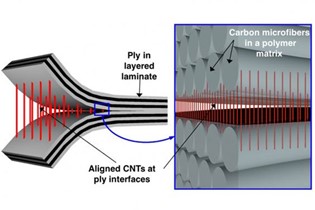Lighter and Tougher Composite Materials in Aircraft

Researchers at the Massachusetts Institute of Technology (MIT) developed a new technique called “nano stitching,” which significantly enhances composite materials’ mechanical properties.
Researchers at the Massachusetts Institute of Technology (MIT), developed this innovation, embedding aligned carbon nanotubes (CNTs) within the interlaminar regions of polymer composites. This process addresses the critical issue of delamination, where layers of composites can separate under stress, by enhancing the material’s interlaminar strength and overall durability.
You can also read: Advancing Supersonic Aviation with Prepreg Composite Materials
Structural Advantages of Composite Materials
Nanostitched polymer composites substantially benefit spacecraft structural components, such as satellite buses and payload enclosures. The composites enhance toughness and reduce weight, leading to the creation of more durable and lightweight structures. These features are crucial for enduring the harsh conditions of space, including extreme temperatures and high radiation levels. By utilizing these composites, engineers can reduce the overall mass of the spacecraft, which is essential for cost-effective launches and increasing payload capacity.
Enhanced Thermal Protection Systems (TPS)
In spacecraft, Thermal Protection Systems (TPS) play a vital role in protecting against the extreme heat encountered during re-entry into Earth’s atmosphere or exposure to solar radiation in space. Nanostitched composites, with their superior thermal properties, are perfect for TPS applications. They provide effective insulation and maintain structural integrity, ensuring the protection of critical components from thermal damage. This capability boosts the spacecraft’s longevity and reliability.
Improved Radiation Shielding

CNTs integrated in Polymer Composites. Courtesy of Massachusetts Institute of Technology
Spacecraft operating beyond Earth’s atmosphere encounter important levels of cosmic and solar radiation, potentially damaging electronic systems, and posing health risks to astronauts.
Integrating carbon nanotubes (CNTs) in polymer composites enhances both mechanical strength and radiation shielding properties. This dual functionality is crucial for protecting sensitive onboard systems and crew members, making these composites essential for long-duration space missions.
Nanostitched polymer composites can selectively reinforce high-stress areas, like joints or mounting points, enhancing structural integrity. This targeted reinforcement actively reduces structural failure risk, thus extending spacecraft operational life. Additionally, incorporating CNTs introduces beneficial properties like electrical conductivity and thermal management. These features contribute to developing multifunctional composite materials.
Eco-Driven Innovation in Aircraft
The industry’s commitment to sustainability redefines aerospace with the introduction of nanostitched polymer composites. By focusing on the recyclability of these advanced materials, companies are pioneering processes that support the recovery and reuse of resources, aligning with the global shift towards more sustainable aerospace practices. This innovative approach not only reduces waste and lowers production costs but also enhances the economic viability of space missions. With their lightweight properties, superior strength, and multifunctional capabilities, these composites are setting a new standard in spacecraft design—making them not only more efficient but also more environmentally friendly. Leading the way in materials science, the aerospace sector is driving the future of space exploration toward a sustainable horizon.
Read the full academic article here: ‘Nanostitches’ enable lighter and tougher composite materials | ScienceDaily
